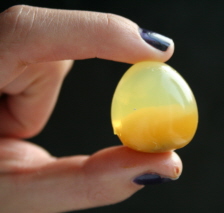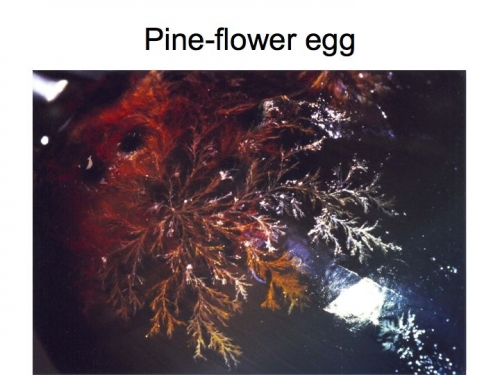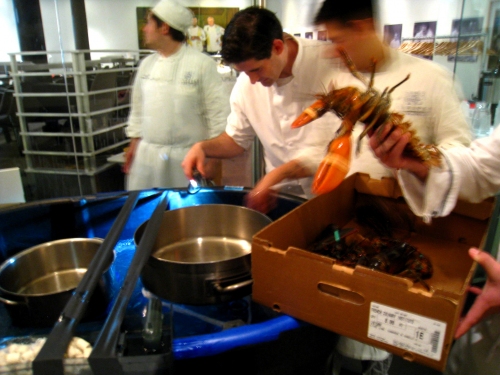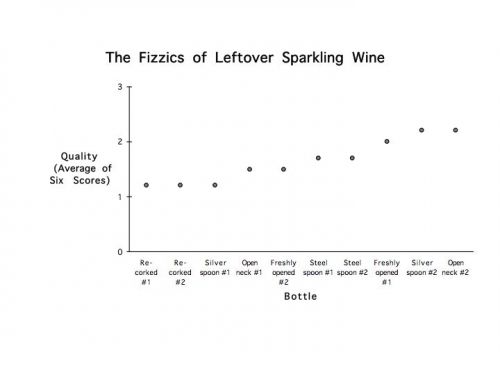
The man himself.
For those of you on who live on the other side of the world or for those who just couldn’t make it down to the FCI for the McGee lecture series, here’s a quick recap of the stuff that went down on Day 1.
Eggs
We started off the morning with one of McGee’s favorite subjects: eggs.
Whipping: the French have been using copper bowls to make egg foams since the 16th century. McGee taught the class that other metals also have the capacity to form extremely tight bonds with reactive sulfur groups. Whether you whip egg whites in a copper, silver , or in a glass bowl with a pinch of powered copper, the foams stay glossy and never develop a grainy texture. Non-metallic alternatives like cream of tarter or lemon juice (acids) have similar effects on sulfur bonding and create equally beautiful peaks. An iron bowl does not stabilize the egg foam for long, but does give the it a really cool silverish color.

Hamine egg on the left; pressure cooked egg on the right; delicious homemade mayonaisse in the middle.
Pressure Cooked Hamine Egg: this egg is cooked in a pressure cooker at 15 psi for one hour. A Maillard reation occurs, the egg whites take on a brown color and the yolk has a creamy consistency. The flavor is “brown” – in the toasty, chicken giblets kind of way.
More Traditional Hamine Egg: we compared the pressure cooked egg to an egg that had been cooking for 18 hours at 70 degrees celsius. The whites of the 70 degree egg were light brown to off-white. The yellow was still very yellow, and there was a slight jade ring around the yolk. This egg started to develop some of the brown flavors of the pressure cooked egg, but not as much as they would have if they had cooked longer or at a higher temperature. The cool thing about these eggs is the structure of the yolk was clearly visible. The yolk in an egg is deposited layer by layer day by day as the egg is developing. You can see those rings in this egg.

Two bratwursts crushing a quail egg.
The Thousand Year Old Egg: this technique of preserving duck eggs has been done in Chinese cultures for the past 500 years. Traditionally, they are preserved in mud and ashes for 1-6 months, and last for a year. Alkalinity is the key player here. Raising the pH of the egg denatures and breaks down the flavorless proteins and the fats into stinky, tasty things. Thousand year old egg whites become a hard, transparent brown jelly, and the yolks become a semisolid with jade coloring. The flavor is earthy and eggy with overwhelming notes of sulfur and ammonia. Some eggs can develop beautiful crystals on the surface known by the Chinese as “pine flowers.” To make a quicker, less stinky version, we stored quail eggs in lye for just five days in a Cambro. The whites became transparent (not brown), and the yolks sank to the bottom of the egg and turned a dark yellow. We like them a lot; but, alas, no pine flowers.

Pine flower crystals on the surface of the 1000 year old egg
Egg Toast With Caviar: For those of you who attended our Star Chefs or New York Culinary Experience Demos, you’ll know that we’re quite fond of this egg trick. Click here for a refresher!
Ike Jime and Lobsters

Making friends between the black fish and the lobsters in our do-it-yourself fish tank.
Ike Jime: After lunch, we went straight into our Ike Jime demo. Eight live black fish and eight live lobsters were delivered in the morning, and we kept them swimming with the help of a chiller that kept the water at 50F, bubblers that provided oxygen, a tank filter duct-taped to the side that continuously cleaned the water, and a few water-filled cambros and jugs that raised the water level.We: 1) Ike Jime’d two fish that had not been anesthesized (which proved a little chaotic when one of the very live fish wriggled out of Dave’s hands and slapped itself onto the laps of a few of the guests in the first row), 2) Ike Jime’d three after they had been anesthesized in Aqui-S for 15 minutes, and, 3) killed two the “Western way”- partial suffocation, and then knocked out by being bludgeoned in the head. One escaped notice until late that evening. It was still sleeping in the tank. It got the full ike-jime treatment. Ike Jime is mentioned a lot on our blog – we know. But this is the first Ike Jime post with an actual video! Check it out by clicking on the video below.
[youtube=http://www.youtube.com/watch?v=YofCpoXkx2Q]
Lobsters: The lobsters were the next to go. Unfortunately we still can’t tell you the really cool tech behind this demo for a few weeks. What we can tell you, is that soon enough you’ll be able to make a damn delicious lobster.
Frozen Desserts
We were exploring ice creams and sorbets with non-traditional textures. Why should an ice creeam need to be smooth and creamy?
Super Gummy Locust Bean Gum Sorbet: locust bean gum is known for its thickening properties and has been used for centuries. The ancient Egyptians used the paste to glue bandages on mummies. We used it to make raspeberry sorbet (not to be confused with Prince’s Raspberry Beret). We took a raspeberry puree and added simple syrup to taste, with 1 1/2% locust bean gum (a ridiculously large amount). After it simmered, we cooled it, tammied it, and realized the acidity and sugar was not right. We added more sugar, froze it while mixing with liquid nitrogen until it became nearly solid, and served. A lot of the raspberry flavor had been stripped, but it had a cool snappy texture that gummed in your mouth like a Fruit Roll Up. Slight locust bean taste, but hey, this was a texture test. What happens when you go beyond too gummy to way too gummy? Does it get good again?
McGee’s Crunchy Ice Cream: McGee (sometimes) likes his ice cream crunchy. He brought some of his homemade uncreamed ice cream which was equal parts heavy cream and milk, a tablespoon per cup of sugar, a dash of salt and vanilla extract. He threw it in a hotel pan, placed it in the freezer and when it started to freeze, he folded the ice cream over (not to upset the larger ice crystals) and served it up. We had a crunchy, delicious vanilla ice cream. This is a riff on an old French recipe. In French it’s called “pin cheese.” The bigger the crystals, the better the job you’ve done. The exact opposite of modern ice cream.
Tiny Bubbles in the Wine
McGee recounted an experiment he conducted a number of years ago dispelling the myth of the spoon in the champagne bottle. Hint: it involved drinking lots of wine.
Spoon in the Champagne Bottle: French folklore insists that placing a silver spoon (handle down) into the neck of an open champagne bottle will keep the bottle fresh and bubbly overnight. McGee put this to the test. A panel of six tasters blind tested an American sparkler and a French champagne with five different treatments ( just opened, left uncorked in the refrigerator for 18 hours, recorked, with a silver spoon placed in the neck 18 hours, and one with a plastic spoon in the neck for 18 hours in case the silver part was important).
The results were interesting. The sparkling wine tasted better when left uncorked overnight and actually improved the flavors. It also lost a fair amount of its carbonation, which turned out to be a good thing because the freshly opened bottle of sparkling wine seemed to have excess bubbly (see below). The bottles with spoons were the same as the uncorked bottle.
The champagne results were completely different. The uncorked, refrigerated bottles absorbed the flavors of the fridge. Gross. Like the sparkling wine, the champagne lost some carbonation, but in this case, the change was bad –it was flat. McGee explained that carbonation levels in the champagnes were lower. The open bottles tasted like the fridge because they didn’t have enough exiting CO2 to push out the stinky odors. The spoon in the bottle trick was also insignificant. Sorry, France.  Does Carbonation Affect Flavor: Overcarbonated wine tastes bad. The oak comes out too much and the fruit is shot to crap. On the other hand, sparklers that have their bubbles removed entirely taste acidic and bad as well. To test this effect Dave used the vacuum machine to suck out the carbonation out of an American sparkler,Gruet , and a French champagne, Gosset. We poured ourselves a taste of the fresh, bubbly bottles first, and then we tried the deflated one. Both the uncarbonated Gruet and Gosset were high in acidity and tasted like cheap, highly-alcoholic sauvignon blanc. Dave recarbonated the Gruet, but over-amped the PSI. As predicted, awful. We realized that to reach the ideal amount of bubbles, the volume of carbonation needs to match the alcohol content of the beverage. For example, champagne carbonates at around 30-35 psi (psi= pounds per square inch – with the common unit of measure being pressure) at 0C. We do our mixed drinks around 40 psi. Wines with a 10-13% abv get an average 30-35 psi, and sake gets about 5 psi higher than white wines (it’s got more booze in it).
Does Carbonation Affect Flavor: Overcarbonated wine tastes bad. The oak comes out too much and the fruit is shot to crap. On the other hand, sparklers that have their bubbles removed entirely taste acidic and bad as well. To test this effect Dave used the vacuum machine to suck out the carbonation out of an American sparkler,Gruet , and a French champagne, Gosset. We poured ourselves a taste of the fresh, bubbly bottles first, and then we tried the deflated one. Both the uncarbonated Gruet and Gosset were high in acidity and tasted like cheap, highly-alcoholic sauvignon blanc. Dave recarbonated the Gruet, but over-amped the PSI. As predicted, awful. We realized that to reach the ideal amount of bubbles, the volume of carbonation needs to match the alcohol content of the beverage. For example, champagne carbonates at around 30-35 psi (psi= pounds per square inch – with the common unit of measure being pressure) at 0C. We do our mixed drinks around 40 psi. Wines with a 10-13% abv get an average 30-35 psi, and sake gets about 5 psi higher than white wines (it’s got more booze in it).
In the next two days McGee and crew will be tricking everyone’s tastebuds, taste-testing french fries, hamburgers and pretzels, yadda, yadda.


You may already know this, but commenting seems to be broken for the post about cocktail dilution. Clicking on the “leave a comment” link goes to a 404 page.
I can’t figure it out
Looks like your description of the photo of the eggs and mayo is backwards, unless my understanding of “brown” and “jade” colors is way off base.
I can’t wait for the info about the lobsters. I hope it’s tech/equipment we already have.
It is.
there was an article on the BBC last month about how much of the flavor of champagne is in the bubbles: http://news.bbc.co.uk/2/hi/science/nature/8279073.stm
I use a fairly inexpensive rubber stopper and pump (< $20) to remove the air from opened bottles of wine and then place back in a wine refrigerator. Doing this will preserve the opened bottle for days, especially if you pump it each day.
Cool stuff! These are the kind of things we love!
Heres an idea… To get rid of the LBG taste in the stretchy ice cream a bit, try sticking some plastic wrap in the puree like McGee did w/ Pernod, and Ideas in Food did w/ Methocel?! Might work w/ some flavor bases better than others as well.
Additives weren’t meant to be used at such high %.
Howdy,
I guess I don’t consider LBG an additive unless it is being used industrially to make something cheaper. It is, after all, only ground up seeds.
Lobster stun: from a make blog story.
http://blog.makezine.com/archive/2009/11/man_invents_electric_lobster_taser.html
Have you ever used one? I saw a lady at the NRA (restaurant, not rifle) show about 3 years ago with an electric lobster killer, but she never brought it by for a tatse-test.